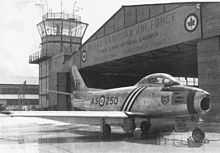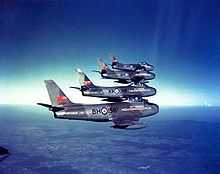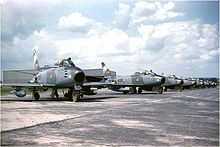RCAF Station Grostenquin
| RCAF Station Grostenquin | |||||||||||
|---|---|---|---|---|---|---|---|---|---|---|---|
| IATA: none – ICAO: none | |||||||||||
| Summary | |||||||||||
| Airport type |
| ||||||||||
| Owner |
Government of Canada 1952–1964 Government of France (1964–present) | ||||||||||
| Operator |
RCAF (1952–1964) French Air Force (1979–present) | ||||||||||
| Location | Grostenquin, France | ||||||||||
| Runways | |||||||||||
| |||||||||||
RCAF Station Grostenquin, also known as 2 (Fighter) Wing or 2 Wing, was a Royal Canadian Air Force (RCAF) station located five km north of the town of Grostenquin in the Moselle department, Lorraine, northeastern France. It was one of four RCAF wings, consisting of three fighter squadrons each, established in Europe in the early 1950s at the beginning of the Cold War. The other three wings were located at RCAF Station Marville (1 Wing) in France, and RCAF Station Zweibrücken (3 Wing) and RCAF Station Baden-Soellingen (4 Wing) in the former West Germany.





These wings were part of the RCAF's No. 1 Air Division which was formed as part of Canada's air defence commitment to the North Atlantic Treaty Organization (NATO). NATO was established to offer a united defence against the increasing threat posed by the Soviet bloc in Europe, and Canada committed to support its European allies with its armed forces.
History
1952–64
No. 2 Wing's three squadrons flew from Canada between September 28 and October 11, 1952 during Operation Leapfrog II. They were the first of the Canadian Air Division squadrons to arrive in mainland Europe, and the first RCAF squadrons to be based on the European mainland since March 1946.[1]
All twelve Air Division squadrons flew the Canadair F-86 Sabre day fighter. The squadrons originally based at Grostenquin were 416, 421 and 430. Beginning in 1956 four all-weather CF-100 squadrons entered service with Air Division. One squadron in each wing was replaced by a CF-100 squadron. No. 416 Squadron was replaced by 423 Squadron at 2 Wing. In 1959 Canada adopted a controversial nuclear strike role in accordance with NATO's doctrine of "limited nuclear warfare" and began re-equipping with the new CF-104 Starfighter that could deliver nuclear weapons. This aircraft also had a reconnaissance role. In the fall of 1962 the Sabre squadrons of the Air Division, including 421 and 430 Squadrons at 2 Wing, were re-equipped with the Starfighter. Concurrently, CF-100s ceased operation in the Air Division and 423 Squadron was disbanded.
Pilots from all three Sabre squadrons at 2 Wing flew with 2 Wing's aerobatic team, the Sky Lancers. The team was formed in March 1955 and performed throughout Europe until October 1955. The following year the team was based at 4 Wing.
NATO bases in France, including Grostenquin, were short-lived. In 1963 the Government of France announced that all nuclear weapons in France were to be placed under French control. This was unacceptable to the RCAF (and other NATO units stationed in France), so the two nuclear strike squadrons at 2 Wing (421 and 430 Squadrons) were hastily relocated; 430 Squadron moved to 3 Wing Zweibrücken and 421 Squadron moved to 4 Wing Baden-Soellingen. RCAF Station Grostenquin closed in 1964.
Post-RCAF
After 1964 the airfield was transferred to the French Armed Forces, but abandoned until 1979 when it was re-used as an electronic warfare training range (POLYGON) by the French Air Force, French Army Aviation Corps, Luftwaffe and USAF.[2]
Other than the hangars most of the RCAF logistics facilities are gone. The runway, taxiways and tarmac remain visible from aerial photos (as late as 2010) but markings have changed since the RCAF left in 1964.[2]
See also
- Ouvrage Kerfent, a former Maginot Line fortification used as a communications relay station by the RCAF in support of Grostenquin.
- Metz–Nancy–Lorraine Airport - a functioning public airport located 40 kilometres (25 mi) west of Grostenquin.
References
- Notes
- ↑ Roberts 1959, p. 245.
- ↑ 2.0 2.1 Abandoned & Little-Known Airfields:France, Lorraine: Moselle Retrieved 2015-01-06
- Bibliography
- Greenhous, Brereton and Halliday, Hugh A. Canada's Air Forces, 1914–1999. Montreal: Editions Art Global and the Department of National Defence, 1999. ISBN 2-920718-72-X.
- Milberry, Larry, ed. Sixty Years—The RCAF and CF Air Command 1924–1984. Toronto: Canav Books, 1984. ISBN 0-9690703-4-9.
- Roberts, Leslie. There Shall Be Wings. Toronto: Clark, Irwin and Co. Ltd., 1959. No ISBN.
- Dempsey, Daniel V. A Tradition of Excellence: Canada's Airshow Team Heritage. Victoria, BC: High Flight Enterprises, 2002. ISBN 0-9687817-0-5.
- Loubette, Fabrice. Les forces aériennes de l'OTAN en Lorraine, 1952-1967 (Part II, Chapter 3, Grostenquin RCAF 2 Wing), Metz (France) : Serpenoise, 2008. ISBN 978-2-87692-763-6.